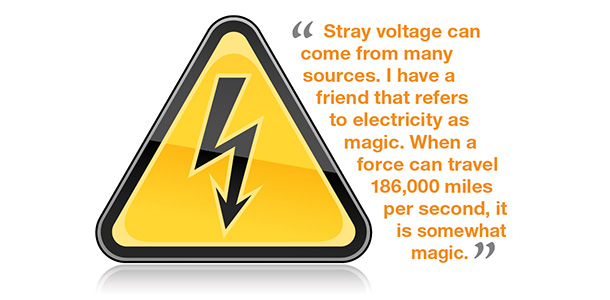Several years ago, I read an article about a dairy farm that was having trouble with nervous, spooky, jittery animals that were not eating well and not producing as expected. During this time, helpers also began complaining about feeling the sensation of small, random shocks or jolts while handling some of the equipment used in the milking process.
Soon the mystery was solved. Unbeknownst to the farmer, his workers and even his livestock had become victims of a phenomenon known as “stray voltage.” Researching the problem with a local utility expert became a priority, and eventually the cause was found.
In this particular case, a very old homemade electrical service had unsatisfactory insulation. The line ran through the feedlot for several hundred feet to another building on the property.
The intermittent aspect was diagnosed as directly correlating to rain; when it rained, the problem got worse due to contamination of the poor insulation. The breakdown of the line’s insulation led to stray voltage leaking in and around the lot.
Another important aspect was the farm’s service ground, which was attached to a water pipe (a common but sometimes bad practice of old). The farm’s electrical system ground had deteriorated to the point of being non-existent, which left the workers and stock (during wet weather in particular) as the shortest path to ground.
An electrical service ground should be a copper rod driven several feet into the ground near the main power disconnect, or near the transformer and service entry disconnect, or both. A qualified electrical contractor can help in these cases.

Still another part of the equation involved the farm being at the end of a long country service. When unnoticed, stray voltage tends to look and act just like more regular system load on utility metering – like a water heater, heat lamp or motor.
The moral of the story is that when the cause of the stray voltage was discovered and fixed the farm had an immediate increase in production – and that’s significant.
Nearly every one of us has been unexpectedly shocked by electricity at one point in our life, whether it was a zap of static from walking across the living room rug or a truly unpleasant jolt from a faulty device. I’m thinking most of us will agree the experience was less than pleasurable.
I would suggest that anyone experiencing sensation in the form of a shock while operating any type of equipment should research the cause and remedy it as soon as possible. It may help you to avoid any further problems or possibly a heart-stopping (stray voltage) accident.
Stray voltage can come from many sources. I have a friend that refers to electricity as magic. When a force can travel 186,000 miles per second, it is somewhat magic. Stray voltage can come from something as mundane as a frayed wire on a plug-in, or from a damaged receptacle that has outlived its initial placement.
It could come from a newly acquired piece of machinery from an auction that looked to be in great shape but had been erroneously repaired. Sometimes it’s caused by bad, damaged or non-existent grounding on the neutral service.
It is important to understand that if service grounding is bad, voltage will be looking for another path to ground, which could be you or your stock standing on a damp or conductive surface.
There are many different factors that determine path and voltage transfer from one object to another. While recently working on my car to try to cancel an engine emissions trouble-light, I was totally confused as to the origin of the code.
I felt I had researched and replaced everything even remotely connected to the original code that indicated an emissions problem.
Then I read a section in the repair manual that suggested a ground or short (stray voltage) on any part of the circuit in a vehicle can cause a misleading fault code. In desperation, I installed a new passenger window up-down switch (the old one had been giving me problems), and voila. The engine emissions trouble-code light went away for good.
Maybe it is magic. PD
Ross Wilkinson is an independent maintenance consultant in Thompson Falls, Montana.






